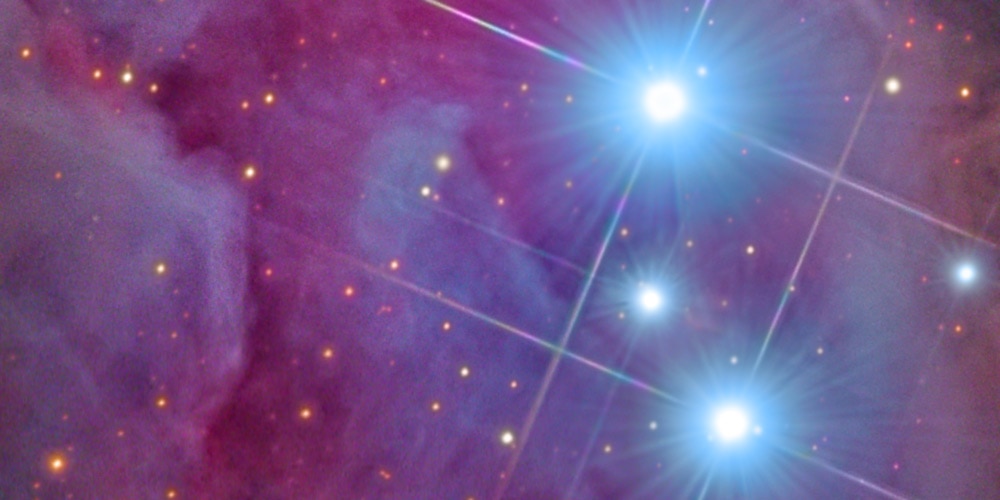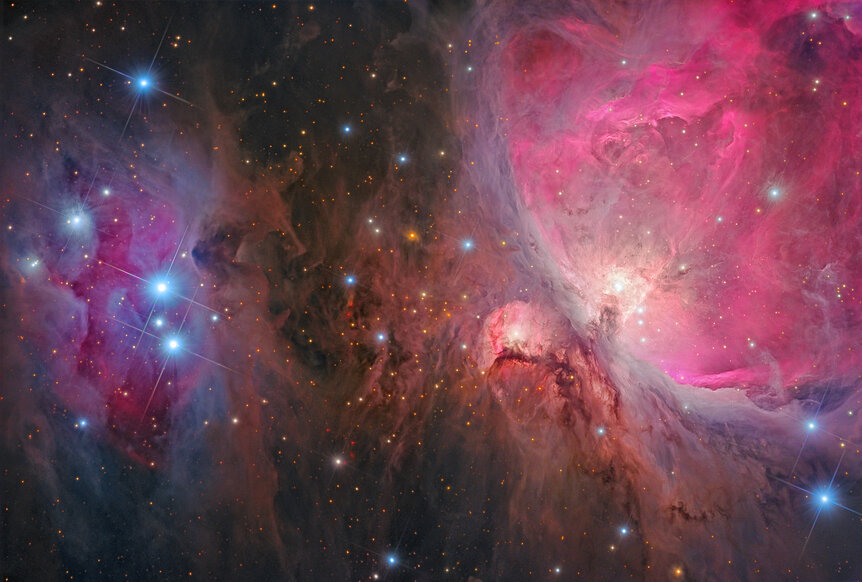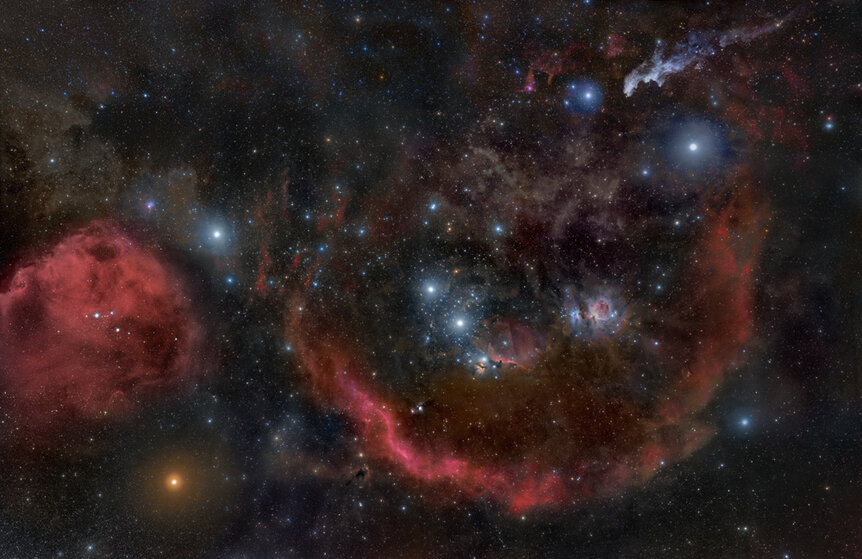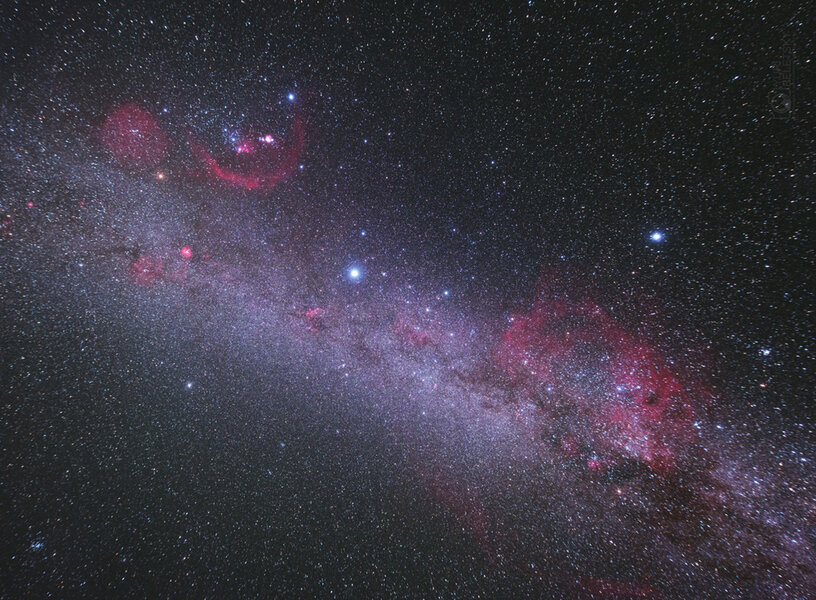Create a free profile to get unlimited access to exclusive videos, sweepstakes, and more!
Stunning astrophotos: Orion in context, and in detail

One of the most beautiful showcase objects in the sky is the Orion Nebula. For those of us in the northern hemisphere nothing else really comes close, and in the southern hemisphere there might be one or two that rival it, but even then I’d make the case for Orion.
It’s visible to the naked eye as the middle star in Orion’s “dagger,” and even then, you can tell it’s not quite star-like. Binoculars show it to be a fuzzy patch, and even a small telescope will show its shape.
And when you take a big ‘scope, attach a really good camera, and let a true expert process the data, what you get is staggeringly beautiful gorgeosity. Behold!
That is the Orion Nebula, folks. Also called M42 (the 42nd object in a catalog kept by comet hunter Charles Messier in the late 18th century), it is a sprawling star factory, a gas cloud where stars are born. It’s a couple of dozen light-years across, and sits well over a thousand light-years from Earth. That’s 10,000 trillion kilometers, and you can see it with your naked eye! It’s so bright because of a handful of extremely massive hot stars sit in its center. They blast out ultraviolet light that energizes the gas in the nebula, causing it to glow.
It’s actually a small section of a much larger dark cloud, what’s called a molecular cloud, that we cannot see directly. Stars were born near the edge of that cloud, not too deeply inside it, and when they switched on their fierce light and stellar winds blew a hole in the cloud, popping it like a bubble. The Orion Nebula is a cavity in the side of that cloud, carved by the newborn stars.
The nebula on the left has many names, including Sharpless 2-279, and more colloquially the Running Man Nebula (if you tilt your head to the left and squint it kinda looks like a person running with their arms outstretched), probably at the same distance as and associated with the Orion Nebula.
This shot, by Rolf Wahl Olsen, is just spectacular. He took it with a home-built 32 centimeter telescope! It’s a total of over seven hours of exposure time, too. Amazing.
That whole region of the sky is lousy with gas. And I can prove it:
Ye. GADS. I know, right? This is one of my favorite astrophotos of all time, called “Orion, Head to Toes”, by Rogelio Bernal Andreo. I wrote up a lengthy description of it at that link if you want details, and by coincidence the image happens to be rotated in roughly the same angle as the closer shot of the nebula by Olsen. It might be hard to see in all that chaotic gas strewn about, but the Orion Nebula is to the right of and just below center, and you can see Sharpless 2-279 glowing to the left of it. The entire constellation of Orion is there, if you can find it! Orange Betelgeuse is to the lower left, blue Rigel to the upper right, and the three stars that make up the famous belt are just below center.
But if we pull back even more, there’s still much to see. Voilà!
This shot is by another astrophotographer I admire, Yuri Beletsky. He took this in the Atacama desert in Chile, and it’s a composite of nine 90-second exposures. It’s very deep for such a short exposure (it was taken with a wide-angle 14mm lens, and you can see some distortions in the star shapes toward the edge due to the optics). I rotated it to match the other two images, and you can find Orion at the top left. The Orion Nebula is now a pink blob, surrounded by the other nebulae in the area. The arc under it is called Barnard’s Loop, and the large disk to the left is the Lambda Orionis Nebula, a cloud of gas lit and warmed by a supergiant star in its center.
The glow diagonally across the shot is the Milky Way, our galaxy itself, appearing as a broad swatch of stars, gas, and dust because it’s actually a flat disk, and we’re inside it. The red cloud to the lower right is actually composed of a lot of different objects in the ridiculously complex area of the sky in the constellation of Vela.
The bright star in the middle is Sirius, the apparently brightest star in the night sky, and to the right is Canopus, only visible in the US from southern states (technically, it rises for any latitude farther south than about 38°N, but the farther south you go the higher it gets; it never rises high enough to see where I live in Colorado).
I find it amazing that the sky delivers such beauty on all scales, with science to be found in each. And did I mention that two of the three photographers featured here —Olsen and Andreo— are what would be considered amateur astronomers? Whatever the word “amateur” means anymore; perhaps it’s time to do away with it. Anyway, you don’t have to be a PhD scientist to appreciate the sky, or to capture it for others to see. That’s one of the things I love about astronomy.
Note: If you like to take photos of the sky yourself, then you should know that the group The World At Night (dedicated to presenting photos of world landmarks against the night sky) is holding their annual astrophotography contest now. The contest always produces stunning results! Submissions are accepted until April 30, 2017.

















